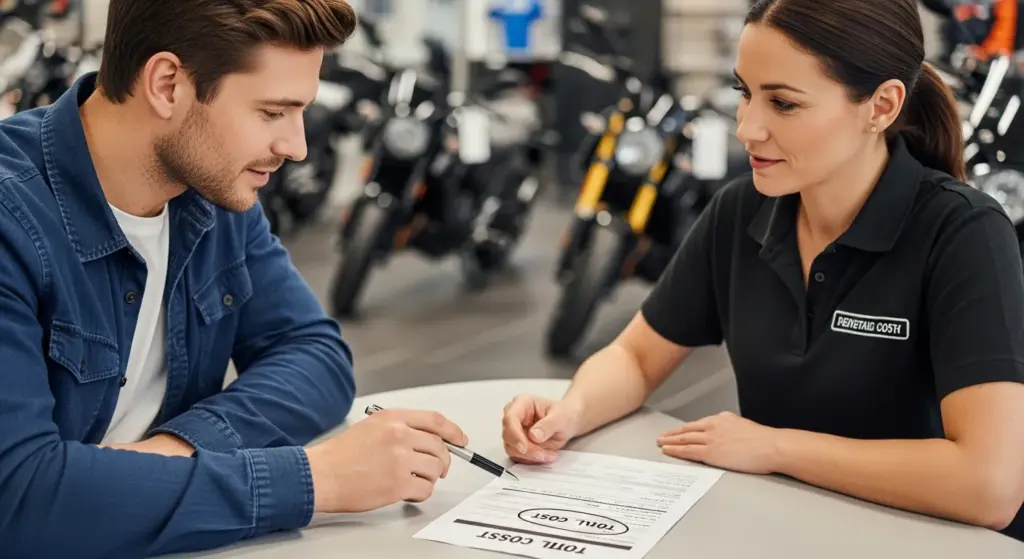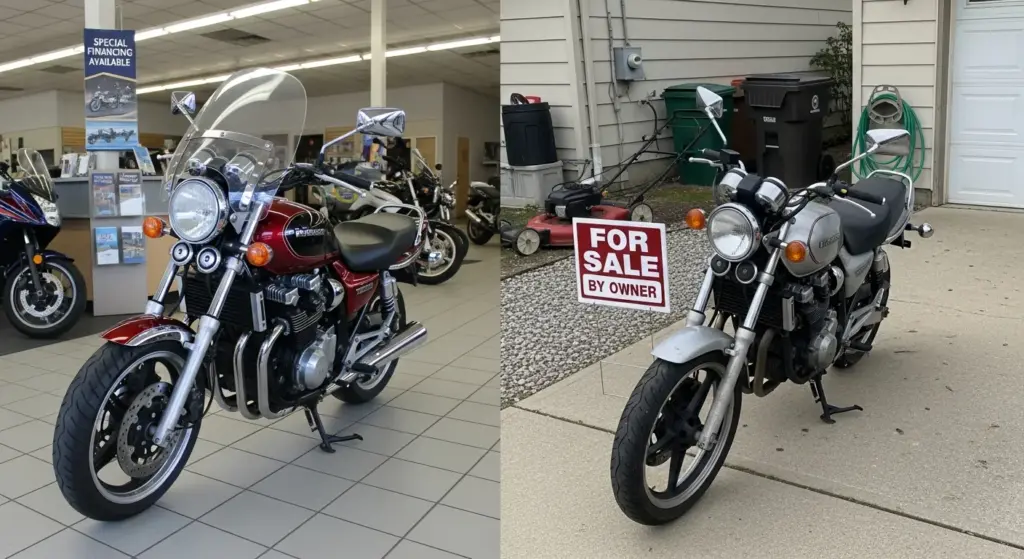Buying a used motorcycle seems simple enough, right? You find a bike that looks good, negotiate a price, and ride away happy. But anyone who’s ever gone through the process knows there’s a catch. Somewhere between the handshake and the paperwork, the final price mysteriously grows. It’s not an accident—it’s the result of hidden fees that quietly pile up when you least expect them.
If you’ve been browsing listings or visiting dealers lately, you’ve probably noticed the same thing: that “amazing deal” on a used bike somehow turns into a few hundred dollars more once you’re at the checkout counter. Let’s dig into why that happens, which fees are legitimate, and which ones are designed to pad profits.
Why Used Motorcycle Prices Aren’t Always What They Seem
On paper, the used market looks fair. Dealers advertise low prices to attract buyers, but in reality, their margins are razor thin. To stay profitable, they add a variety of small charges that sound official but aren’t always necessary.
These hidden costs often hide behind vague labels like “processing fee,” “reconditioning charge,” or “administrative cost.” A first-time buyer might shrug and assume everyone pays them—but seasoned riders know better.
The truth? Some of these fees have no clear explanation other than “that’s just how we do it.”
When you’re shopping for your next bike, understanding these add-ons can save you hundreds of dollars—and a lot of frustration.
The Most Common Hidden Fees (And How They Sneak In)
Let’s break down the ones you’ll see most often.
1. Documentation or “Doc” Fees
This one shows up on nearly every sales sheet. Dealers claim it covers the cost of filing your paperwork with the state. In reality, the process is usually quick and inexpensive. In the U.S., some states cap this fee legally (often under $100), but others don’t—meaning dealers can charge whatever they like.
Real-world example: A used Yamaha MT-07 might list for $6,000, but you’ll find a $395 “doc fee” added at signing. That’s nearly 7% more—just for a few minutes of admin work.
2. Reconditioning Fees
This one’s tricky because it sounds fair. Dealers say it covers inspection, cleaning, or minor part replacement. But here’s the kicker—they already did that before listing the bike. It’s part of the selling cost. You shouldn’t have to pay for a service that’s already baked into the price.
Pro tip: Ask for an itemized list of what was actually reconditioned. If it’s just “oil change and detailing,” you’re within your rights to question the charge.
3. Setup or Preparation Fees
Setup fees are supposed to apply to new motorcycles that arrive in crates, but some dealers sneak them into used sales too. If you see this on a pre-owned bike, push back immediately. There’s no assembly needed for a bike that’s already been on the road.
4. Freight Charges
Like setup fees, freight is legitimate for new bikes. It covers shipping from the manufacturer to the dealer. On a used motorcycle, though, it’s often just an invented line item. The bike is already there. You shouldn’t pay for imaginary transport.
5. Credit or Financing Add-Ons
When you finance a used bike, some dealerships tack on “lender service” or “credit processing” fees. Others add costly protection packages or extended service contracts by default. Always read the fine print before signing anything.
Many buyers are so focused on getting approved that they overlook hundreds of dollars buried in these documents.
Why Dealers Add These Charges

Let’s be fair—dealerships aren’t villains. They operate in a tough market where profits on used motorcycles are slim. A $500 doc or prep fee might be their way to stay in business.
But transparency matters. A good dealer explains each charge before you see the invoice. A shady one waits until you’re emotionally invested in the bike.
From a business perspective, these extras often come from corporate policy or manufacturer partnerships. Salespeople have little control, but you, as the buyer, do.
That’s why research and timing are everything. Visiting at the end of the month or shopping during slow seasons can give you more leverage to negotiate fees down—or remove them entirely.
The Psychology Behind “Hidden” Fees
Ever notice how people will argue over $100 on a motorcycle’s sticker price but quietly accept a $399 doc fee? That’s by design. Dealers know most buyers focus on the headline number, not the fine print.
It’s called price framing—anchoring your perception around a base price so add-ons feel small in comparison. A $300 charge seems minimal next to a $6,000 bike.
In other words, the hidden fee game is as much about psychology as it is about accounting. Recognizing that helps you keep control of the negotiation.
How to Protect Yourself From Hidden Costs

Knowledge is power. Here’s how smart riders avoid paying more than they should:
1. Ask for the “Out-the-Door” Price Upfront
Before you even visit the dealership, ask for the total cost—taxes, title, registration, and all fees included. A transparent dealer won’t hesitate to tell you.
2. Get a Breakdown in Writing
Ask for an itemized list before signing. Seeing “Reconditioning – $299” in black and white makes it easier to question.
3. Compare Across Dealers
If one dealership insists on $800 in fees while another includes everything in the sticker price, you’ll know who’s playing fair.
4. Don’t Be Afraid to Walk Away
The most powerful tool you have as a buyer is the ability to leave. Dealers hate losing a sale over a few hundred dollars—they’ll often waive or reduce fees if they sense you’re serious.
5. Consider Private Sellers
While buying from individuals comes with its own risks, it usually means fewer fees and more room for honest negotiation.
What Other Riders Are Saying
Scroll through motorcycle forums or social media, and you’ll see countless riders sharing stories about hidden dealership charges. Some paid an extra $600 on a used Harley, others were shocked to see “handling fees” on a 10-year-old Honda.
The common thread? Lack of clarity. Riders feel frustrated not because of the money itself, but because of the surprise.
Transparency builds loyalty, and the best dealers know that. If your local shop takes time to walk you through every cost, that’s a place worth supporting.
You can find more real-world buyer experiences and advice in our Motorcycle and Finance sections on RideTrailBlaze.
Micro Insight: When It’s Worth Paying Extra
Not every add-on is bad. Some dealerships genuinely perform extensive inspections, oil changes, brake checks, or warranty coverage. If you’re getting that level of service, a modest reconditioning fee might be fair.
The key is value—are you getting something tangible in return?
As a general rule, if you can see or feel the benefit (fresh tires, updated fluids, new battery), the fee is easier to justify. If it’s just “admin,” “prep,” or “doc,” it’s usually negotiable.
The Bigger Picture: The Used Bike Market in 2025
The used motorcycle scene has exploded lately. With inflation biting into new bike prices, many riders are turning to pre-owned models for better value.
But that demand gives dealers more leverage to slip in fees, knowing bikes are moving fast. The more informed buyers become, the more likely the market will shift toward transparency.
Even some manufacturers are encouraging certified pre-owned programs with standardized pricing—something the car industry did years ago. That’s a good sign for riders who hate surprises at checkout.
Final Thoughts
Buying a used motorcycle should be exciting, not stressful. You’ve done your research, found the perfect model, and imagined your first ride. The last thing you need is an invoice that ruins the mood.
Hidden fees might be common, but they’re not inevitable. With a bit of preparation and confidence, you can avoid paying for vague line items that don’t serve you.
At the end of the day, it’s about clarity and respect between rider and dealer. Ask the right questions, read every paper, and don’t rush.
Because when you finally roll that bike out of the lot—knowing you paid a fair price—it feels that much better.
